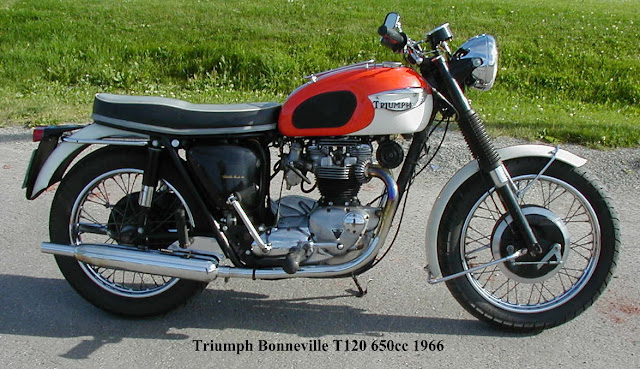Triumph Thunderbird 650
This 1957-model T-bird’s handsome styling is similar to that of Triumph's 499cc models, but the 649cc engine delivered useful extra performance.
Thunderbird hatidling was improved with the arrival of Triumph’s twin-shock chassis in the mid-1950s, but it was for straight-line speed that the model remained best known.
The world’s most inviting motorcycle market in the 1950s was the USA, where Triumph boss Kdward Turner, in particular, was eager to exploit the potential presented by hordes of performance-hungry motorcyclists and a struggling home industry.
Turner’s enthusiasm led directly to one of Triumph’s most significant models, because it was largely American demand for more cubes and power that led to the Thunderbird, the British firm’s fastest bike yet.
Essentially the T-bird, as it was commonly known, was a 650cc version of Triumph’s existing 500cc Speed Twin. Enlarging the pushrod-operated parallel twin engine to 649cc gave a peak output of 34bhp at 6300rpm, a gain of 7bhp over the Speed Twin (4bhp over the sportier Tiger 100), plus a healthy increase in torque throughout the range. This resulted in a significant performance boost because at 3851b (175kg) the Thunderbird weighed barely more than the smaller models.
Triumph launched the Thunderbird in September 1949 at the banked circuit of Montlhery, near Paris, where the first three bikes off the production line were ridden for 500 miles (805km) at an average speed of over 92mph (148km/h), with a last lap of over 1 OOmph (161km/h). Apart from minor modifications including fitment of rearset footrests and racing tyres, they were standard, so it was an impressive introduction. Predictably the T-bird was well received in Britain and abroad. More even than its top speed, it was the torquey 650’s ability to maintain a high average that impressed testers. ‘So fast is the Thunderbird that during the test the maximum speed at which the machine could be cruised, without engine fatigue becoming apparent, was never determined,’ reported The Motor Cycle. ‘When road conditions permitted, speeds of 80, 85, 90mph [129, 137,145km/h] were often held for as’ long as the rider could withstand the buffeting force of wind pressure.’
High excitement
In America, Cycle magazine’s test declared the T-bird almost faultless, though the original model’s blue colour was unpopular. Triumph’s American advertising emphasized the performance, screaming: ‘See the most exciting motorcycle ever!’ from the pages of the 1950 New York Show programme. ‘Why be satisfied with second-rate performance, choose a Triumph and get ahead.’ Thousands did just that, and the Thunderbird became a huge success for Triumph, firmly establishing the marque on the American market. The model received a boost in 1953 from the movie The Wild One, in which Marlon Brando’s lead character rode a 1950 model Thunderbird. Until this point, motorcycles had appeared in films with their tank badges covered up. But the T-bird starred m all its glory, and plenty of extra sales resulted.
Handling was good without being outstanding and was improved in the mid-1950s when Triumph introduced a new twin-shock frame, replacing the original model’s option of hard-tail or sprung°-hub rear suspension. A further chassis improvement came in 1960, when the Thunderbird was also one of numerous models to receive Triumph’s controversial ‘bathtub’ enclosed rear end. By this time the T-bird had been relegated to a touring role by the faster Tiger 110, but its place in Triumph’s history was assured.
Left: Triumph’s pushrod twin had been hugely impressive in its original 499cc capacity, but gained valuable power and torque when enlarged to 649cc to power the Thunderbird. In this form it has a single Amal carburettor, separate four-speed gearbox, and maximum output of 34bhp. It vibrated at high revs, but was reliable as well as fast.
Specification Triumph Thunderbird (1957)
- 9me Air-cooled ohv pushrod four-valve parallel twin
- Capacity 649cc (71 x 82rnm)
- Maximum power 34bhp @ 6300rpm
- Transmission Four-speed, chain final drive
- Frame Steel cradle
- p sion Telescopic front: twin shocks rear
- Brakes Drum front and rear
- Weight 3851b (175kg)
- Top speed 103mph (166km/h)


















0 comments: